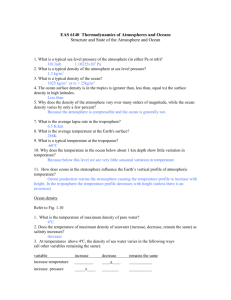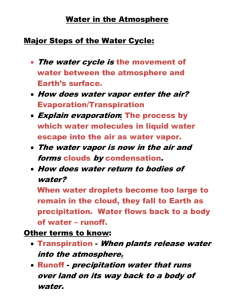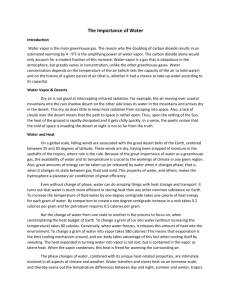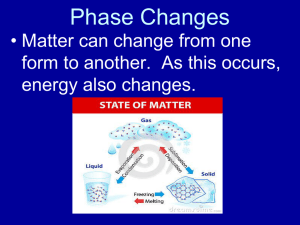MoistAdiabat_micro
advertisement
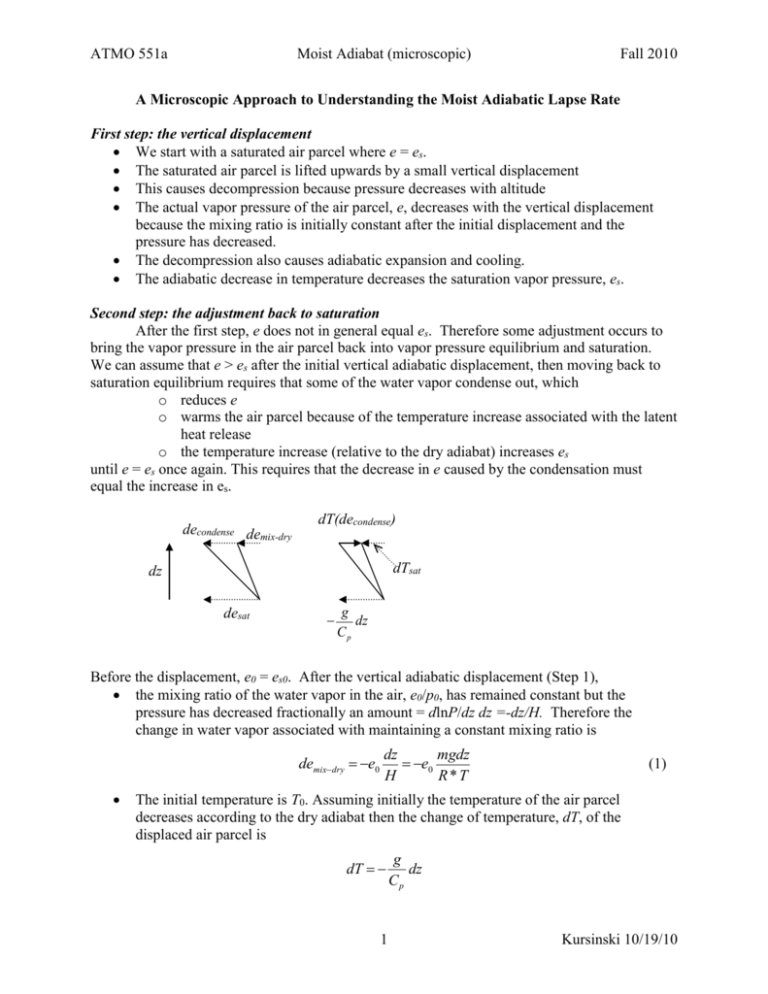
ATMO 551a Moist Adiabat (microscopic) Fall 2010 A Microscopic Approach to Understanding the Moist Adiabatic Lapse Rate First step: the vertical displacement We start with a saturated air parcel where e = es. The saturated air parcel is lifted upwards by a small vertical displacement This causes decompression because pressure decreases with altitude The actual vapor pressure of the air parcel, e, decreases with the vertical displacement because the mixing ratio is initially constant after the initial displacement and the pressure has decreased. The decompression also causes adiabatic expansion and cooling. The adiabatic decrease in temperature decreases the saturation vapor pressure, es. Second step: the adjustment back to saturation After the first step, e does not in general equal es. Therefore some adjustment occurs to bring the vapor pressure in the air parcel back into vapor pressure equilibrium and saturation. We can assume that e > es after the initial vertical adiabatic displacement, then moving back to saturation equilibrium requires that some of the water vapor condense out, which o reduces e o warms the air parcel because of the temperature increase associated with the latent heat release o the temperature increase (relative to the dry adiabat) increases es until e = es once again. This requires that the decrease in e caused by the condensation must equal the increase in es. decondense demix-dry dT(decondense) dTsat dz desat g dz Cp Before the displacement, e0 = es0. After the vertical adiabatic displacement (Step 1), the mixing ratio of the water vapor in the air, e0/p0, has remained constant but the pressure has decreased fractionally an amount = dlnP/dz dz =-dz/H. Therefore the change in water vapor associated with maintaining a constant mixing ratio is demixdry e0 dz mgdz e0 H R*T (1) The initial temperature is T0. Assuming initially the temperature of the air parcel decreases according to the dry adiabat then the change of temperature, dT, of the displaced air parcel is g dT dz Cp 1 Kursinski 10/19/10 ATMO 551a Moist Adiabat (microscopic) The change in saturation vapor pressure at the new temperature is des0 es0 Fall 2010 L dTs dz RvT 2 dz (2) In general des0 < demix-dry (note that both of these are negative). This means some water vapor will condense out and the temperature of the air will warm relative to the dry adiabat. The solution is just enough water must condense out to warm the air just enough so that the air remains at saturation as it rises, no more, no less. Water vapor emixdry econdense esat <0 <0 (3) <0 If the vertical displacement is upward, all of these changes are negative. We rearrange the equation to solve for the amount of water vapor that condenses out econdense es emixdry (4) Plugging in for the change in the saturation vapor pressure and the change due to the decrease in pressure with altitude while holding the water vapor mixing ratio constant eL mgdz (5) decondense s v2 dTs e0 RvT R*T Temperature Next, we work through a similar sequence for the temperature dTdes dTaddry dTdecondense <0 <0 (6) >0 Note that the temperature change due to the condensation is positive. The condensation releases latent heat that causes the temperature of the surrounding air to increase. To determine the amount of latent heat released and the resulting temperature increase, we need to know the mass of water vapor condensed. This is done using the ideal gas law. We can use the ideal gas law for partial pressures de dnv R*T dv RvT (7) such that dvcondense decondense RvT (8) Therefore the amount of latent heat released per unit volume is Lv dvcondense Lv 2 decondense RvT (9) Kursinski 10/19/10 ATMO 551a Moist Adiabat (microscopic) Fall 2010 This is transferred into the heat capacity of the air. The density of air is air P RT (10) Therefore the energy transfer is Lv decondense P airC p dTcondense C p dTcondense RvT RT (11) Lv R decondense Lv v decondense C p Rv P C p d P (12) dTcondense Now we need to be very careful of the sign of this term because we have defined decondense to be negative but the change in air temperature is positive. So we rewrite (6) (6) dTde dT dT dTde s s dTs dz Ts z condense g Lv v decondense C p C p d P (13) esLv mgdz dTs e0 2 RvT R*T (5) g Lv v 1 esLv mgz 2 Ts e0 C p C p d P RvT R * T (14) decondense Now we plug (5) into (13) Ts1 addry g L e g g L e g L2v v es z v v s d z v s 2 C p RvT d P C p C p d P R * T C p C p P RvT Ts1 L2v v es g e L z 1 s v 2 C p RvT d P C p P RvT es Lv 1 P Rv T dTs g dz C p L2v v es 1 2 C p Rv T d P (15) So the moist adiabatic lapse rate is a scaled version of the dry adiabatic lapse rate. From the other derivation, we have L qM 1 C s A R*T M D LC qs LC MW 1 c pT R * T (39) These are the same. 3 Kursinski 10/19/10 ATMO 551a Moist Adiabat (microscopic) Fall 2010 Compare this to the definition form the ams glossary at http://amsglossary.allenpress.com/glossary/search?id=moist-adiabatic-lapse-rate1 Note that es = es(T) and Lv = Lv(T) which makes integrating (15) versus altitude a bit tricky. We did not consider in (15) the subtle change in Cp as the amount of water changes or the heating of the condensed water when the vapor condenses. The denominator term in parentheses can reach a value of 2 under very warm moist conditions such that the moist adiabat can reach an extreme value of ~ –0.5 g/Cp = -5 K/km. 4 Kursinski 10/19/10



